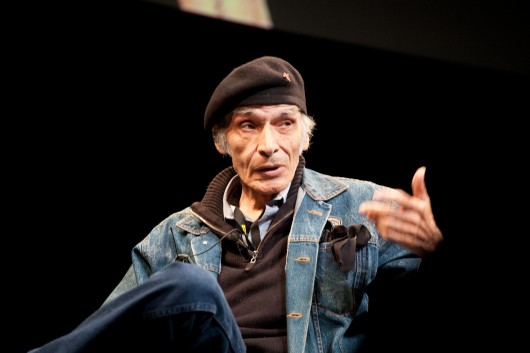
Photo by: Amber Gregory
They discussed his move from rural spain to Brooklyn, New York – a transition that traumatized him. He described it as moving from grass to the “tyranny of the straight line.” He stayed away from gangs and went to one of New York’s specialized art high schools where other creatives like Tony Bennett and Calvin Klein attended. Then he went to Cooper Union which he chose over the other art schools because Cooper was free. He said he learned more from the students than the teachers. Wanting more training, he attended Yale where he studied with color theorist Joseph Albers.
He then moved to San Francisco, and when he received a draft notice, he enrolled at the San Francisco Art Institute to get deferment. In San Francisco, he saw his first psychedelic poster which he thought was, “crude but interesting.” He was drawn to the density and absence of white space. He gave his first poster a try and described it as, “the worst work I ever did.” He was so disappointed that he didn’t make another poster for five months. His words of wisdom were that you learn more from your failures than successes. With successes, you only know you guessed right. With failutres, you need to figure out what you did wrong and learn from your mistakes.

Victor Moscoso is one of the premier artists of the psychedelic era. Raised in Brooklyn, he attended both Cooper Union and Yale (where he studied with Joseph Albers) before moving to San Francisco in the late 1950s. There he became a primary architect of the burgeoning underground hothouse that would produce brilliant posters, comic books, and album covers. Moscoso's facility with color relationships and his remarkable ability to seamlessly blend images and lettering into a single entity was used to create a series of groundbreaking concert posters that propelled him to international fame. His posters feature dizzying hand lettering that push the very limits of negative space, and fierce battles between foreground and background. Along with Robert Crumb he was a founding member of the groundbreaking underground comic Zap Comix. Moscoso also designed numerous album covers for Jerry Garcia, Herbie Hancock and others.
The posters were the main form of advertising at the time. Through his posters, he learned to take everything he learned in school and do the opposite. Rather than legibility being most important, lettering show be as difficult to read as possible. The harder you make it to read, the longer the viewer will stand in front of the poster.
Negative shapes are as beautiful as lettering. He transformed his lettering into flowers and flames. Adding lights, the butterflies can fly and the lips can talk. His mastery of color relationships and blending of images and lettering into the posters propelled him to international fame.
He was also a proponent of ownership and copyrighted and trademarked his and his friends’ work. His Zap Comix was owned by the artists – a model that affected Marvel and DC Comics.
His tips for new designers is every time you get a “No” from an art director, ask for recommendations on others who might like your piece and go down that list. Do not take “No’s” personally; pursue what you like.
Text — By Diana Banh — @dibanh























